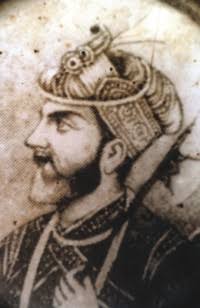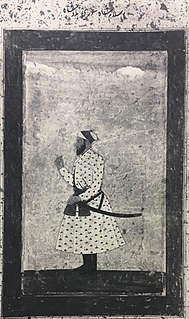Related Research Articles

Nasir-ud-Din Muhammad, better known by his regnal name, Humayun;, was the second emperor of the Mughal Empire, who ruled over territory in what is now Eastern Afghanistan, Pakistan, Northern India, and Bangladesh from 1530 to 1540 and again from 1555 to 1556. Like his father, Babur, he lost his empire early but regained it with the aid of the Safavid dynasty of Persia, with additional territory. At the time of his death in 1556, the Mughal Empire spanned almost one million square kilometres.

The Second Battle of Panipat was fought on 5 November 1556, between Akbar and the king of Delhi Hemu. Hemu had conquered Delhi and Agra a few weeks earlier by defeating Mughal forces under Tardi Beg Khan in the battle of Delhi and crowned himself Raja Vikramaditya at Purana Quila in Delhi.

Sher Shah Suri (1472, or 1486 – 22 May 1545), born Farīd Khān , was the founder of the Sur Empire in India, with its capital in Sasaram in modern-day Bihar. He introduced the currency of rupee. An ethnic Pashtun ruler, Sher Shah took control of the Mughal Empire in 1540 CE. After his accidental death in 1545 CE, his son Islam Shah became his successor.

Mandu or Mandavgad is an ancient city in the present-day Mandav area of the Dhar district. It is located in the Malwa and Nimar region of western Madhya Pradesh, India, at 35 km from Dhar city. In the 11th century, Mandu was the sub division of the Tarangagadh or Taranga kingdom. This fortress town on a rocky outcrop about 100 km (62 mi) from Indore is celebrated for its architecture.
The Marwat is a Pashtun tribe, a branch of the Lohani tribe and belong to Lodi section, located primarily in Lakki Marwat District, parts of Dera Ismail Khan District, some villages of Tank district in Pakistan and in the Katawaz area of Afghanistan. The Marwats are also known as Spin Lohani, and their most closely related kin are other Lohani tribes like Miankhel (Pasani), Daulat Khel and Tatur. The Marwats were named for their ancestor Marwat Khan Lodi.

Hemu was an Indian emperor who previously served as a general and Wazir of Adil Shah Suri of Sur Empire during a period in Indian history when Mughals and Afghans were vying for power across North India. He fought Afghan rebels across North India from Punjab to Bengal and Mughal forces of Humayun and Akbar in Agra and Delhi, winning 22 battles for Adil Shah.

Rohtas Fort is a 16th-century fortress located near the city of Dina in Jhelum district of the Punjab province of Pakistan. The fort is one of the largest and most formidable in the subcontinent. Rohtas Fort was never taken by force, and it has remained remarkably intact.

Isa Khan was a Muslim Rajput zamindar who was one of the Baro Bhuiyans and a Zamindar of Khizirpur in 16th-century Bengal. Throughout his reign he resisted the Mughal empire invasion. It was only after his death that the region fell totally under Mughal control.

Rao Maldeo Rathore was a king of Marwar from the Rathore dynasty, who ruled the kingdom of Marwar in present day state of Rajasthan. Maldeo ascended the throne in 1531 CE, inheriting a small ancestral principality of Rathore's but after a long period of military actions against his neighbours, Maldeo swept significant territories which included parts of present day Rajasthan, Haryana, Uttar Pradesh, Gujarat and Sindh. He refused to ally with either the Sur Empire or the Mughal Empire.
Isa Khan Niazi was an Afghan noble in the courts of Sher Shah Suri and his son Islam Shah Suri, of the Sur dynasty, who fought the Mughal Empire.

Islam Shah Suri was the second ruler of the Suri dynasty which ruled the part of India in the mid-16th century. His original name was Jalal Khan and he was the second son of Sher Shah Suri.

Muhammad Adil Shah was the fourth ruler of the Suri dynasty, a late medieval Afghan dynasty of northern Indian subcontinent.

Sikandar Shah Suri was the sixth ruler of the Sur dynasty, a late medieval Pashtun dynasty of northern India. He became the sultan of Delhi after overthrowing Ibrahim Shah Suri.

The Rohtasgarh or Rohtas Fort is located in the Son River valley, in the small town of Rohtas in Bihar, India.
The Battle of Tughlaqabad was a notable battle fought on 7 October 1556 between a Hindu king Hem Chandra Vikramaditya, also known as Hemu and the forces of the Mughal emperor Akbar led by Tardi Beg Khan at Tughlaqabad near Delhi. The battle ended in a 'victory of Hem Chandra' who took possession of Delhi and claimed royal status, assuming the title of Raja Vikramaditya. Following his failure, Tardi Beg was executed by Akbar's regent, Bairam Khan. The two armies would meet again at Panipat a month later with opposite results.
Taj Khan Karrani was the founder of the Karrani dynasty, a Pashtun dynasty of Karlan-Pashtun origin that ruled Bengal, Orissa and parts of Bihar.
Haibat Khan Niazi was an Afghan noble and military leader. He was the most powerful noble of Sher Shah Suri and Commander of the Niazi contingent of his army. He is best known for bringing law and order in Multan by destroying the power of Balochs and Fetah Khan Jat who were laying waste to entire South Punjab. Sher Shah Suri granted him the title of Azam Hamayun and appointed him governor of Punjab.
The Battle of Sirhind was fought between the Mughal Empire and the Suri Empire in 1555.
The Battle of Machhiwarra was fought between Mughal Empire and Suri Empire in 1555.
The Battle of Kannauj took place at Kannauj, Uttar Pradesh, India between Sher Shah Suri and Humayun on May 17, 1540. This battle is also known as the battle of Bilgram, Humayun was defeated by Sher Shah Suri in the battle.
References
- ↑ John Hutchison and Jean Philippe Vogel, History of the Panjab Hill States, Vol. 1, (AES, 1994), 137.
- ↑ Dr. Syed Charagh Hussain Shah mentions “Ghawas Khan Marwat” as one of the famous Generals of Sher Shah Suri, when he defeated Mughal King Humayun in 1539. Ghawas Khan had also joined Haibat Khan Niazi and Isa Khan Niazi in their victorious campaigns in Bengal and Bihar. He was killed in a battle for power fought by Saleem Shah Suri. Other known figures in the line were: Sepoy Khan, Asghar Khan, Sikandar Khan, Gul Khan and Nur Khan (sons of Khawas Khan), Dr Syed Chiragh Hussain, Dood-e-Chiragh. (DI Khan. Ishrat Art Press. 1980). PP 31-34
- ↑ Mughal Empire in India: A Systematic Study Including Source Material, Volume 1, page 124
- ↑ "Khwas Khan of Rohtas". 23 December 2011.